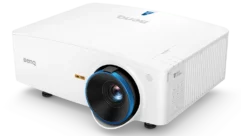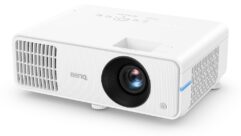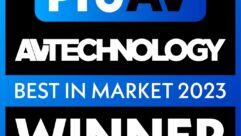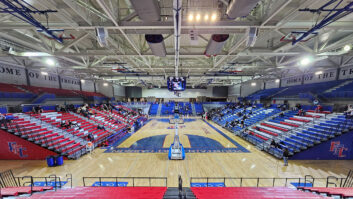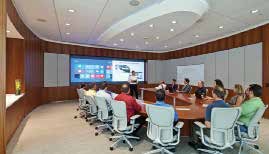

“There are many options for the use of projection, many more than are being utilized today,” said Rodney Laney, vice president of display technology, AVI-SPL. “The fact is, hanging a flat panel is faster in most cases, but is not always the best solution for where they are being used. This is especially the case with laser projectors and the ultra short-throw lenses available for them, combined with the high contrast, high resolution, and ambient light-rejection screen products available today.”
Projection is far from dead, agreed Scott Walker, president of Waveguide. “There are current limits to flat panel technology size before we have to deal with mullions/seams that many find objectionable. Also, projection technology is mature and cost-effective for many applications for years to come, especially in markets like higher education where room sizes still dictate the need for larger images than can be economically accommodated by comparably sized, direct-view technology.”
It’s worth noting that in K-12 and higher ed, the ubiquity of blackboards and whiteboards is not waning, he added. “Roll up projection screens have the ability to easily and quickly ‘disappear’ from in front of those surfaces while barring expensive rigging; flat panels cannot. In high-finish architectural spaces, architects may prefer to have the display system not permanently block a feature wall or window. Projection screens have other advantages. Good quality projection screens can remain perfectly operational for 30 years, outliving multiple projector upgrades. Flat panels must be refreshed frequently, and the big ones require specialized wall constructions for support and can be an ADA violation if they protrude from the wall more than four inches.”
There are new opportunities for specialized projection environments being created. “Short-throw projectors and image-warping technologies can provide some unique solutions in challenging physical environments to place images where you need them,” Walker said. “Projection mapping is another growing field where we can exploit the latest image manipulation tools to create ‘placemaking through AV.’”
In fact, unique applications include projection mapping used for large live shows, Laney noted, often used with buildings as the projection surface. “The release of the many laser products in the market is making it easier for projection mapping to be used in smaller venues since there are rarely any orientation issues with the laser products. The market where there is the opportunity for sustaining projection technology remains in large images. Projection is an option for images more than 100 inches and up to 400 inches and beyond at a fraction of the cost of Direct View LED or flat panel video walls. Sony has the only commercial panel that is 100 inches diagonal and that has a $65,000 MSRP. The only other unit larger than 100 inches was a consumer unit, and it had a whopping $120,000 MSRP.”
There also may be opportunities for screen manufacturers in developing better write/erase projection surfaces to address the increasing popularity of interactive ultra short-throw projectors, particularly in the K-12 market, Walker said. “Additionally, paint-on surfaces (Goo Systems) are very popular; they are relatively inexpensive and easy to repair/repaint, but need an expensive Class 5 wall surface. There’s opportunity for a manufacturer that can solve this conundrum or provide a more innovative, affordable roller-applied solution.”
AT THE EDGE
One reality check on the desire for increased video resolution is that no matter how much resolution a client wants, the typical floor height of a building is probably not going to change by very much. “In other words, building heights are not going to be driven by the need to make larger images,” Walker said. “Thus, one way to have a more dense pixel pallet in a space is to widen the image through edge-blending technologies to create very wide pixel pallets across features and walls within a space.

Edge blending is another option that makes projection a very costeffective option for large and often very wide image needs, Laney added. “Many times, edge blending is built into the projectors that would be used for images of this type. At the most basic level, you must be able to adjust the image brightness where the images overlap to a point where that overlap is not apparent.”
Projectors that include native edge-blending capability can be very helpful in managing budgets, Walker noted, but Waveguide most often will specify an outboard edge-blending solution to address the number of simultaneous windows and resolution requirements of a specific installation. “For us, a key consideration is ease of use in setting up and maintaining the edge blending and controllability of the device from a third-party control system.”
THE SCREEN, SPECIALIZED
Waveguide sees specialized screen solutions in two primary applications, Walker said. “First, we are seeing more need for ambient light-rejecting screen materials like the DNP Supernova family of screen solutions. With most walls in an office building being glass these days, we’re battling more and more ambient light. These screens can maintain image contrast in these harsh lighting environments. Second, we see architects and interior designers wanting to push the envelope on creative solutions for presenting images in the built environment. Having surfaces that are semi-transparent but can also serve as projection surfaces has shown some resurgence.
“We’ve also seen architects and content creators looking to break out of the rectangular paradigm to embrace other shapes or multiple aspect ratios within a design,” he added. “Often these unique environments are in experiential environments like museums.”
The greatest advancements in screens are the products that reject ambient light to a point where projection can literally be used in daylight conditions, Laney explained. “Custom screen design is typically a matter of very large screens and/or very long black drops for special applications. Video processing is the secret sauce behind the wild and out-of-the-ordinary images we see; screen manufacturers will build screens to fit the image designs being produced by the video processors. Screen selection is based on many factors, such as the viewing cone, the amount of lighting control, and the amount of ambient light that will be in the space on average, to name a few.”
Screens are an essential, but often overlooked, part of the image equation,” Walker stressed. “The projector is just part of the story. The screen gain, half-angle viewing cone, backing, ambient-light rejection, and many other factors will have an impact on the perceived quality of the image seen by an audience.”
While flat panels may rule for 75 to 90 percent of the spaces Waveguide specifies in a given year, the fact remains that the 10 to 25 percent of spaces that still require projection have a higher bar to hit to look comparable to the contrast, clarity, and color rendering of emissive flat panels, which may live in the same space as the projected image, Walker said. “Hence the need for screen solutions that present the projected image in the best light possible—pun intended.”


